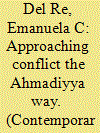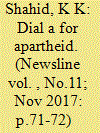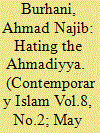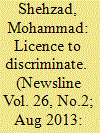| Srl | Item |
| 1 |
ID:
131480


|
|
|
|
|
| Publication |
2014.
|
| Summary/Abstract |
The role and incidence of the Ahmadiya community in Israeli society, with its around 2,000 members, is not related to the dimension of the community, its religious activities or its dissemination on the territory. It is related to the strong social and political engagement of the community not only in religious but also in civil society activities where it resides, despite all the difficulties that derive from its disputed role in Islam. The Ahmadiyya community in Haifa constitutes a relevant example of contribution to peaceful and productive coexistence. Haifa itself is characterized by a very interesting social and political climate, by which it is considered a "model" of coexistence in Israel, despite the fact that many contrasts and contradictions persist, such as forms of discrimination and inequalities. The civil society is particularly active, and institutions and NGOs devoted to the Arab-Jewish dialogue are many. Religious and political leaders communicate and participate together in various events, where their openness and mutual respect are intended to symbolize harmony with the intent of this being mirrored by the whole society. The Ahmadiyya Community plays an active role in this evolving process. The author, who has carried out qualitative research in Haifa to film a scientific documentary on the Holiday of Holidays and the validity of the Haifa model of coexistence, applied participant observation in the framework of grounded theory to analyze the role and impact of the Ahmadiyya community in the complex Israeli context, also on the basis of extensive in depth interviews with community members and leaders
|
|
|
|
|
|
|
|
|
|
|
|
|
|
|
|
| 2 |
ID:
156226


|
|
|
| 3 |
ID:
131481


|
|
|
|
|
| Publication |
2014.
|
| Summary/Abstract |
Religious diversity and pluralism is commonly understood within the context of the relation between various religious traditions, not within a single religious tradition. This limitation of the boundary of religious pluralism could overlook the fact that conflict within a single tradition can be bitterer and more disastrous than conflict with other religions. In the last decade, for instance, the Ahmadis in Indonesia have become victims of constant attacks. This article, therefore, intends to study the place of the Ahmadiyya in the context of religious pluralism in Indonesia by answering the following questions: Why was the treatment of the Ahmadis in recent years by Muslims more vitriolic than their treatment of non-Muslims? What is the nature and quality of life for people who have been excluded from a 'normal' religious identity in a time when religious attachment is a necessary fact for that society? Why did the attacks on the Ahmadiyya occur in the present regime, not during the past authoritarian one? This article argues that the charge of heresy issued by Muslim institutions put the Ahmadiyya in liminal status; they are in the zone of indistinction between Muslims and non-Muslims. This makes them vulnerable to persecution since they have been deprived of their rights as Muslims, while their rights as non-Muslims are still suspended. Non-Muslims, particularly ahl al-kit?b (People of the Book), have been accepted theologically in Muslim society, but there is no place of tolerance for heretics. The rise of intolerance in Indonesia parallels the rise of religious conservatism after the fall of Suharto in 1998.
|
|
|
|
|
|
|
|
|
|
|
|
|
|
|
|
| 4 |
ID:
122873


|
|
|